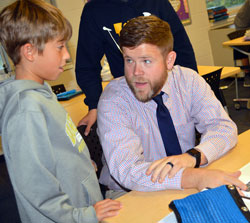Chase Stanley-Eldrid has his sights set on becoming a Navy Seal.
Cardiology is the goal for Karina Chung, like both her parents.

Titus Storrs plans a career as a journeyman lineman: “They’re the guys who go up when there’s a power outage, either by climbing or in a bucket truck,” he explained.
Solid professions all, for sure. And for those in two algebra classes taught by John MacKenzie II, having a career in mind now comes with a heaping helping of reality in the form of a budgeting lesson.
The exercise is part of the percentages unit in MacKenzie’s class. Once students selected a profession, they researched the average salary for that career and were given a set of non-negotiable expenses such as insurance, a place to live, transportation and food. They could then add extras such as entertainment, fancy vehicles, charitable giving and travel.
“Percentages can be abstract for my students to think about, but this is something they will be able to apply to their lives,” he said. “Math gets a bad reputation for not being applicable to real life, but often that’s just a matter of a missed connection.

‘What they also take from doing it this way is they come back having had conversations with their parents that they weren’t having before,” he added, noting that “parent feedback at conferences is really strong.”
MacKenzie recalled growing up in a family that owned restaurants, where costs and budgeting were freely discussed. He said the number of Americans who have less than $400 in savings cannot be attributed only to poverty.
“A lot of it is middle-class families who still live paycheck to paycheck,” he said.
A big part of getting a handle on expenses, he said, is knowing what they are and how much they cost.
Chase, the future Navy Seal, thinks the exercise will help him “in pretty much everything, knowing how to budget.”
His biggest takeaway? “Everything is, like, so expensive.”














